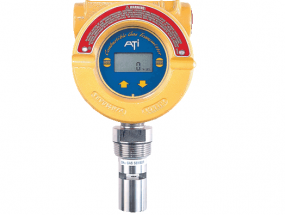Producten



ATi A12 Toxic / Combustible Gas Detector
2-Wire Toxic Gas Transmitter: ATI Model A12
The universal 2-wire gas transmitter provides the most economical and flexible gas measurement system available today, handling 28 different gases. The UniSens transmitter combines universal electronics, bench calibration capability, automatic sensor verification, fault detection and alarming, and superior sensor technology.
How it works:
The sensing modules consist of an electrochemical gas diffusion sensor and a solid state memory assembly. The companion memory assembly stores operational information and calibration constants, along with gas sensor identification, sensing module range, and software revision level. Complete sensing modules are housed in convenient snap-in packages that mate easily with UniSens transmitters.
Features and Benefits:
Our electrochemical sensors provide excellent response time, maximum selectivity, and superior temperature stability for reliable gas sensing in a wide range of environments. Versatility – the UniSens transmitter is designed for ambient gas monitoring in various industrial environments; gas storage areas, gas compressor rooms, process piping galleries, rail car sidings, analyzer shacks, gas cabinets, chemical process areas, and more.
Combustible Gas Transmitter: ATI Model A12-17
The Auto-Test Combustible Gas Transmitter doesn’t require frequent maintenance or response checks. It provides a high level of reliability through its combustible gas detector system which conducts an automatic gas test on the sensing element every 24 hours –reducing manual testing.
General issues and standard methods:
Combustible gas detectors are used within industrial plants to detect gas leakage/build up before it reaches explosive levels. This is done via thermal oxidation of gas – burning the gas and measuring the heat released.This standard method can require regular maintenance to prevent poisoning by silicon vapour, lead compounds, and other environmental contaminants.
How it works:
Combustible gas sensors are made up of two matched sensing elements, one active and one passive. Both are electrically heated and form two legs of a Wheatstone bridge circuit. When combustible gas contacts the sensor, the active element catalyzes the oxidation of gas, heating the active element and changing its resistance. The passive element remains unchanged, resulting in a change in the bridge circuit that is proportional to the gas concentration. As long as the active element remains in good condition, the sensor will respond rapidly to the presence of combustible gas.
Features and Benefits:
Auto-Test: The result of each auto-test is logged in transmitter memory. The hydrogen generator can be manually activated to observe sensor response. Non-intrusive Calibration: Magnetic transmitter controls allow adjustments without removing enclosure cover.
Please download the technical documentation for further details and complete gas parameter overview
- A12 2-Wire Toxic Gas Transmitter Datasheet
- A12 2-Wire Toxic Gas Transmitter Manual
- A12 2-Wire Toxic Gas Transmitter Support Drawings
- A12-17 Combustible Gas Transmitter Datasheet
- A12-17 Combustible Gas Transmitter Manual
- A12-17 Combustible Gas Transmitter Support Drawings
Fabrikant

